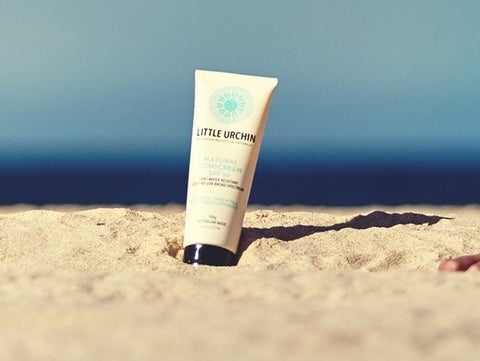Free Shipping For Orders Over $75 NZD
Free Shipping For Orders Over $75 NZD

With the shift towards chemical-free beauty and baby products, it is important to know the difference between natural and chemical-based sunscreens before diving right in. Here we explain the difference between the two, whether they are safe for babies and where to buy natural, non-toxic sunscreen in Australia.
What is natural sunscreen?
Natural sunscreen differs from traditional, chemical-based sunscreen formulas as it is made of naturally-sourced ingredients and minerals such as Zinc Oxide. Under revised guidelines issued by the Therapeutic Goods Administration in Australia in 2019, the term ‘natural’ cannot be applied to ingredients that undergo a chemical refinement, purification and transformation process in the laboratory without qualification. That is why Little Urchin is in the process of qualifying its ingredient list to identify those that are natural and organic and those that undergo a laboratory process to make them suitable for use in the final product. All sunscreens of SPF30 or more, whether they are naturally-sourced or chemical-based, must undergo the same testing in Australia meaning that naturally-sourced sunscreen is just as effective in blocking damaging UV rays.
What is the difference between naturally-sourced and chemical-based sunscreen?
Naturally-sourced sunscreens create a natural, physical barrier to the sun’s harmful rays whereas chemical-based sunscreens utilise a chemical barrier. Naturally-sourced sunscreens usually contain Zinc Oxide which provides a film on top of the skin that reflects and scatters UV light. While absorbing UV rays, chemical-based sunscreens penetrate the skin with chemicals that are potential endocrine disruptors, i.e, they have a hormonal effect on humans.
Zinc Oxide has been used in skincare products for centuries. Today, Zinc Oxide is typically derived synthetically from the mineral zinc. Studies demonstrate that Zinc Oxide doesn’t harm coral unlike oxybenzone and octinoxate, two of the most toxic chemical ingredients that do harm coral and are found in 40% of sunscreens within the Australian market. Zinc Oxide doesn’t dissolve in seawater so it settles on the seafloor where it becomes buried in sediment, like silt.
Little Urchin sunscreen is made with Zinc Oxide, contains no nasties, is preservative free and is suitable for the whole family (6 months and older) as a body and face sunscreen. Free of dangerous chemicals, it does not contain any UV absorbers, titanium dioxide, parabens, synthetic preservatives or synthetic fragrances.
Is it available in Australia?
Little Urchin Natural and Tinted Natural Sunscreens are available throughout Australia and online at Little Urchin. Little Urchin sunscreen products are reef safe and eco-friendly to help ensure the protection of the natural habitats of all living creatures including the beautiful Great Barrier Reef.

How to choose the right natural sunscreen for you
When choosing the best sunscreen for you, experts say there are several key factors to consider, as well as personal preference, of course. Firstly, look for sunscreen with an SPF of 30 or more. (SPF levels higher than 30 offer only marginal additional protection). Secondly, ensure the sunscreen offers protection against both UVA and UVB rays. Thirdly, the sunscreen should suit your activity type, for example be water-resistant for swimming and playing sports.
For those with sensitive skin and prone to allergies, a non-toxic sunscreen is likely to be far less irritable than chemical-based sunscreens.
How much is enough?
Research shows that Australians are using less sunscreen than necessary but what’s the magic amount? Sunscreen manufacturers recommend liberal application. Choice defines ‘applying liberally’ as:
Make sure you are careful to re-apply after swimming and keep in mind that sunscreen rubs off on clothing and towels.
Always read the label. Wear protective clothing, hats and eyewear when exposed to the sun.